December 9, 2011
Temple University: That’s a new one
I spent three days at Temple University in Philadelphia this week and had what can only be described as a memorable experience. In a good way.
Temple has a new Director of Bands, Emily Threinen. Emily is young, extremely talented, fun to watch, and driven. Before she arrived, the band at Temple only performed in the spring, never brought in guest composers, and seemed to be a sort of anonymous ensemble on campus. Emily is working to change all of that. The band performs throughout the school year now, playing more than double the concerts they played in the past, and she’s bringing in two guest composers every year. I was honored to be the first.
Temple performed two of my pieces while I was there — “Hymn to a Blue Hour,” and “Harvest,” my trombone concerto. The soloist on “Harvest” was Nitzan Haroz, Principal Trombone for the Philadelphia Orchestra. Nitzan = rock star. More on him in a moment.
Emily is a great host, and the students work really hard under her direction. I stayed in Center City, a wonderful part of Philadelphia (basically across the street from the Kimmel Center, the home of the Philadelphia Orchestra). Meals were good (although three separate people took me to the same restaurant — where I am now a regular! Great place, although their website plays annoying music when you click that link.). I had a nice meeting with conTemplum, the Temple student composers’ organization. (I did appreciate that I was allowed to speak to the student composers, since that, um, doesn’t happen everywhere…) It was All Good. The rehearsals were good, and Nitzan is a monster player. Nitzan told me after one rehearsal, “I wish we could perform the piece several times. I think people might be a little nervous the first time around. I had more fun learning this piece than I’ve had learning any other concerto, and I want to play it in a way that reflects that feeling, but this performance might be a little nerve-wracking for everybody. If only we could play it several times!” “You should do it on a subscription week with the Philly Orchestra,” I believe I responded. I mean, how else could he perform the piece multiple times in quick succession? Ha. Stay tuned.
At the concert, the first half of the program went just fine. The students gave a nice performance of “Hymn to a Blue Hour.” Then, intermission. So far, so good. The second half started with a piece by Ned Rorem, whose music I liked until he dissed me at a performance at Carnegie Hall several years ago. (I mean, come on. You have a piece right before mine, you get up to bow, then you go back to your seat — which was RIGHT BEHIND MY SEAT! — sit down, put on your coat, and leave the concert – seconds before my piece starts, and my piece was the last thing on the program? You couldn’t wait 8 more minutes? Was there some big clearance sale on silk scarfs that you had to rush to? Whatevs.)
I spoke to the audience about “Harvest,” then took my seat to listen to the performance.
It started just fine. Intro: fine. The fast music started going, and it was okay. Everybody sounded a little nervous, but it wasn’t bad or anything. Just… not as comfortable and confident as it could. Nitzan is an incredible player, looking completely engaged in the music even when he wasn’t playing. During the drum break, he’d bob his head and look back to the percussion section, smiling. He played some more, and he sounded great. There aren’t many places where he doesn’t play, but he stopped playing during the rests, continued bobbing his head, slid his page of music to the next page, and…
He didn’t come back in.
The accompaniment continued with its oom-pah jazzy thing, but there was no tune on top, because Nitzan wasn’t playing. He was sliding his pages around on his stand. Then sliding a different page. He still looked totally comfortable, as if nothing was wrong. But something was very wrong. His pages were out of order. He was lost.
Were they going to have to stop? Emily avoided looking at Nitzan, sensing that if they made eye contact, he would stop the performance and start over — and we were about four minutes into the piece. Emily spotted a good re-entry point, prepped it, and cued Nitzan, who came back in. I think he was probably only lost for about a dozen measures or so. I suspect only three people in that hall knew that anything was ever wrong.
The rest of the performance went just fine. During the curtain call, Nitzan hugged Emily and said something to her, she said something back, he said something to her, she again said something back (I think she was saying, “no way in hell”), and Nitzan raised his hand to quiet the audience, and he stepped up to the microphone.
“I’m sure you could tell what happened there,” Nitzan said. “I got my pages out of order, and because of that, you missed the best part of the piece. You all, and John, deserve to hear the piece the way it’s supposed to go, so we’re going to do that first movement again. I need to go backstage for a drink — maybe a glass of wine — but in about 30 seconds, I’m coming back out, and we’re going to play the beginning again.” He paused, then added, “you can leave if you have to.” The audience applauded, and Nitzan left the stage – but nobody else left.
I’ve had a lot of performances where, as I sat there, I thought, “this isn’t going well. I wish they’d do it again.” The performance at Temple was not one of those performances. Sure, there was no solo part for a few measures, but the piece still came of very well. Everybody had sounded a little nervous throughout, just as Nitzan had predicted the night before, and the first movement sounded more tentative than party-like, but it was still very good. Since everything had gotten back on track after a short time, we didn’t need a “do-over.” But we got one.
Nitzan returned to the stage, and he, Emily, and the ensemble repeated the first movement. And it was… spectacular. The nerves were gone. There was a level of confidence and energy and fun that are rare in any performance. It sounded, well, like a party, and it felt like one throughout the hall. Whereas I’d sat nervously during the first performance, during this encore performance, I just smiled and enjoyed the energy in the room. It was the most laid-back performance I can remember, but that level of informality made for a more exciting, care-free (but clean!) performance. If only I could share it!
Ah, but I can! Somebody — I don’t know who — captured it on their phone, and posted it to YouTube. Here’s the repeat of the first movement, starting with me telling the audience that a “do-over” really wasn’t necessary, but I wasn’t going to argue. It ends a little weird (not surprisingly, considering they were only doing the first movement, which doesn’t have a set ending, but continues directly into the next movement), but I love it.
Again, my sincere thanks to Dr. Emily Threinen, the students at Temple, and the absolutely bad-ass Nitzan Haroz. I guess from now on, I need to insist that the dress rehearsal be part of the actual concert, ’cause the result is confident, exciting performance.
At the reception after the concert, a complete stranger named Renee joined our group because she “can tell who the most fun people in the room are.” (I guess she missed the pair of hookers in the next section.) She asked Nitzan, who is from Israel, “where are you from? Are you from Jersey?” I guess that’s where the exotic people come from. (Our upstairs neighbor is Albanian, and somebody once asked him if that meant he was from Albany.) Nice to meet you, Renee. (Surrounding her are Jay Krush, Temple’s tuba professor, and Travis Cross, he of great and often distasteful humor.)
Jay, you don’t look as convinced as Travis.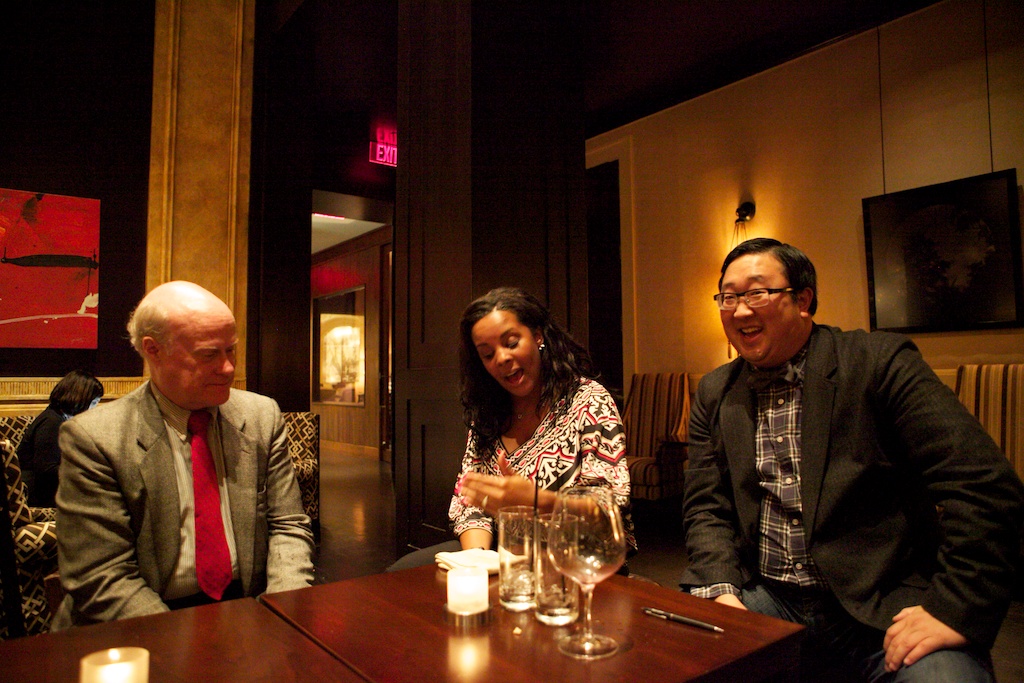
That’s more like it!
Congratulations to Emily on her first semester at Temple — and thank you for having me on campus! This was a great trip. And Nitzan: any time you want to perform “Harvest,” even if it’s multiple times in a night, you have my blessing.
November 1, 2011
How it’s fixed: Drum Music
A few weeks ago, I posted a big blog entry about how I constructed the second movement of my new percussion concerto, Drum Music. (If you want to skip to the new demo recording now, without reading all of this blog post, you can click this. But I’ll be very sad.) The piece premiered on October 11 at Tennessee Tech University, with Eric Willie playing the solo part, and Joseph Hermann conducting.
The first movement, “Infiltrate,” worked fine “in real life,” and I don’t think it needs to be heavily revised. There are some small corrections, and I’ve decided to ask for a sizzle cymbal rather than a standard suspended cymbal, but that’s about it. (For future reference: Moving a 5-octave marimba is a pain in the ass.)
In the second movement, “Incubate,” I added one new very crunchy note to the chorale at the end of the movement – a chorale which had been straight-up all-white-note harmony, even though there had been a lot of G#’s earlier in the movement. (You may have seen the blog post about the writing process for that movement.) The revision came about through an email exchange with composer David Rakowski. (Rakowski – I’ve said it before, and I’ll say it again – has the best composer blog on the InterTubes.) After hearing the original MIDI, Dr. Davy said:
“As to the G-sharps — they seem sometimes strangely tragic and very expressive. They feel sad, even. Funny that musically there gets to be so much weight on what an analyst would simply gloss over as a detail… If I were to analyze your G-sharp, I’d either call it a Neapolitan to the implied tonic G that is tragically unresolved, or an appoggiatura to an A minorish chord that is a vagrant chord. But really what it is is a sad note.”
This got me thinking two things: First, why did I always resolve the G# to an A? What if it resolved downward – to that G-natural? And second, if the G# (or Ab) is a “sad” note, why did I abandon it before the climax of the movement? What would happen if it appeared one more time, right before the end of the movement, but this time, I resolved it down to G, instead of up to A?
So I tried it, saving this resolution for the huge chorale at the end of the movement, and — holy crapolli, it’s fantastic. See measure 55 of movement 2, “Incubate.”) It’s amazing what a big change a single note can make – and what a difference it is when it’s treated as an Ab instead of a G#.
As a reward, I had some banana pudding from Bobby Q’s in Cookeville, Tennessee.
There’s an unintentionally cool moment in the second movement when the soloist has to bow the vibraphone while also playing it with mallets. What I didn’t consider was the fact that if I wasn’t careful, the soloist would have to bow between the mallets. I, um, wasn’t careful. Awfully cool visual, though – and Eric nailed it.
The only other change to the second movement was the doubling of what was originally a single trombone line, but is now also in low trumpets (rehearsal “N”). Okay, and I also revoiced the sax parts. And the clarinet parts. In the original, I was trying to be a little too clever. In this case, simple is better. (I also stuck a bunch of tempo tweaks in the new MIDI demo to make it more free in time — and more musical — but that doesn’t count.)
So, through two movements, only a few tiny revisions! That’s not so bad!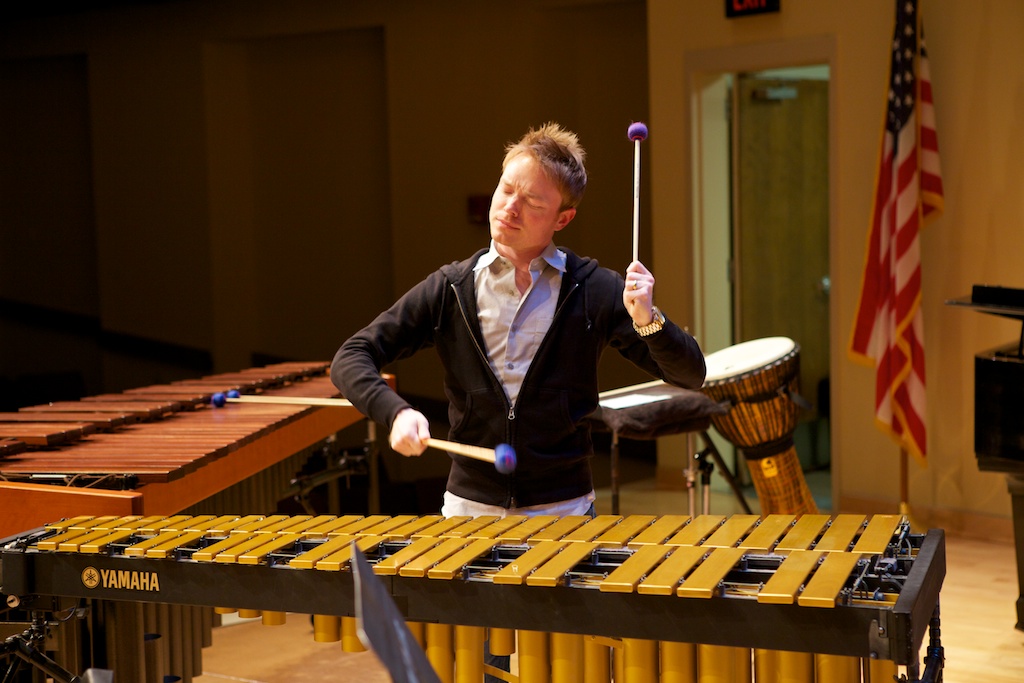
Then there’s the third movement, “Incinerate.” Damn it. I kind of blew this one.
First, there were the balance problems. It turns out that if you stick a percussion soloist in front of an ensemble and ask said soloist to play fortissimo tom-toms and cymbals, you can not hear the band. This was a problem in my first percussion concerto, but that one had an orchestral accompaniment, and I figured “band is louder than orchestra, so balance shouldn’t be a problem.” Well, I was wrong.
Eric Willie and Joe Hermann were very patient and accommodating with me as I tried to figure out how to make the accompaniment audible. We took the bottom heads off the toms, making them punchier and giving them less ring. This helped a little (I definitely liked the drum set-like punch), but not enough to fix it. I asked to hear the band play on its own, thinking maybe they were playing “concerto dynamics” – as in quieter than marked, so they wouldn’t cover the soloist. Again, I was wrong. Without the soloist, the band was clearly very, very loud. The drums were just louder.
So we moved Eric to the back of the stage and put him on a riser. This was a great solution, as it allowed him to play the first movement and two-thirds of the second movement from the front of the stage (where he played primarily marimba and vibes), then he worked his way to the riser for the end of the second movement, where he wails on a bass drum. The music is designed to be pretty dramatic anyway (going from quiet vibraphone to fortississimo bass drum is going to be dramatic), but the visual of watching the soloist walk to the back of the stage and ascend a 2′-tall platform before hitting the bass drum was awfully effective. He stayed on that riser for the whole last movement, which visually was much cooler. He totally looked like a rock drummer. The balance issues were largely fixed. Largely.
But not entirely, because, again, I had screwed up the scoring of the last movement. Some low register parts, originally written just for low saxes, bassoons, and bass clarinets, were completely covered. Eric really couldn’t play much quieter in these parts and still get the ultra-punchy rock drummer sound I was after. In other words, the problem was not Eric, or the ensemble. The problem was my orchestration. I’d been tricked by the balance I heard in the MIDI, where I can make a middle C on a flute sound louder than a trombone.
The other day, Eric sent me a video of his performance of the concerto. (You can find said video on YouTube.) Now I found an entirely new problem: my trumpet writing. In order to get a big, bright sound in a few places, I put multiple trumpets in unison – sometimes as many as three of them. Not a good idea in general, but especially bad when they’re unison above the staff. Playing fortissimo.
In the hall, it wasn’t so bad, but when you hear the recording, which takes away a lot of the “safe cover” provided by a very reverberant hall, you can hear what I accomplished. Not just volume. On the recording, much of the last movement, because of the upper trumpets in unison, sounds like… marching band.
I have nothing against marching band, as I’ve made very clear in past blog posts. But you don’t score something for indoor performance the way you have to score it for outdoor performance. I made the classic orchestration error: I thought “more players = bigger sound.” No, “more players” is almost never the best solution. “More players” in general makes band music sound like “band music,” and “more players of the same instrument in unison,” especially if those instruments are clarinets or trumpets, makes an indoor ensemble sound like a marching band.
I had no choice but to revise the last movement – and revise it considerably. Material that was originally scored just low winds and marimba (rehearsal letter “O”) now has low-register straight-muted bass trombone with a few hits of harmon-muted trumpet, stopped horn, and harmon-muted upper trombones. When the “tune” comes in (rehearsal letter “P”), the entire bass line was lost in the hall, so now the solo part is marked down a bit dynamically, the trombones are marked louder, and now they play with accents where they once has staccatos. (Staccatos on power chords? What the hell was I thinking?) My weird little countermelody is now doubled in harmon-muted trombone, which should add a bright, odd color to the texture. But a good odd.
I’d always hated measures 42-43. Totally dorky, I thought, but I couldn’t figure out a better solution. They’re now less awful, thanks to a better (in this case, simpler) solo part, and the addition of a nasty trombone section glissando into the next bar. You can get away with a lot if you have a ballsy trombone section gliss to distract from other problems.
There’s now a loud, atonal thing in the xylophone part starting at measure 75. I dig the atonal obligato against the pretty straightforward tonal chord progression in the rest of the ensemble. The crunchier harmonic language probably again owes a bit to Rakowski’s influence.
At rehearsal letter “R,” when the tune comes in a second time, I used to have trumpets in unison in one octave (going up to D above the staff — in unison!), and the horns in unison an octave lower.
No. Bad. Very, very bad. Horns in unison : a GREAT sound. But the trumpets — ouch, at least when they’re high. In the revision, there are four trumpets — two in unison on the top octave, two in unison on the bottom octave (with the horns), but for each pair, one player is open, and the other plays with a harmon mute. (That’s going to be a bitch to get in tune, but if it ever is in tune, it’ll be a nice color.) I also lowered some ridiculously high parts that, at this tempo, sounded a bit too “jazz lead trumpet,” which was never the goal. I love Earth, Wind, and Fire, but this piece is not that. Unfortunately.)
I took a similar approach in the big chorale (which is a quote and expansion of the chorale from the second movement – only with “rock drums” underneath it here, transforming it to arena rock — bust out your cigarette lighters if you’ve traveled from 1982; bust out your cell phone if you’re from the present). No trumpets in unison above the staff. Now, just a single player, while the other three play the chord progression. Lordy, it’s better.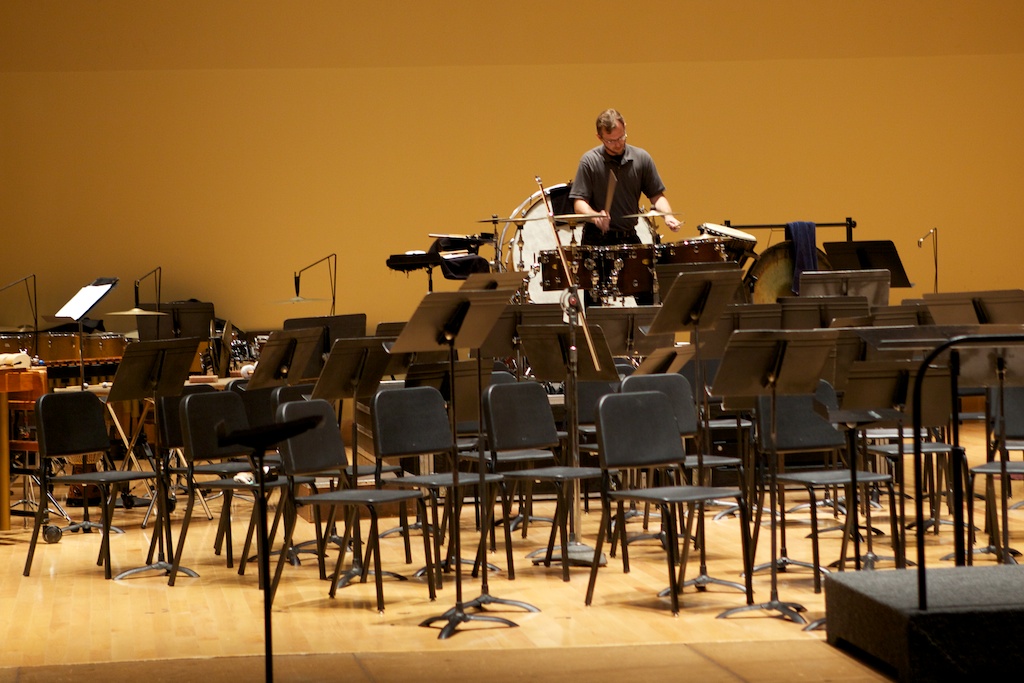
I also made considerable revisions to the solo part. Many of my original fills sounded too similar to one another, as if I was rushing when I was writing them. When I listened to the piece after I finished it (or originally thought I’d finished it), the solo part didn’t do what my ear wanted it to do, or what I tried to “air drum.” (Yes, I wrote the solo part by air-drumming it.) Now, though, the solo part is “correct.” Measures 65-69 are now much cooler. (I’m pretty excited about measure 68 in particular.) There’s a lot more emphasis on the lowest tom (or mounted kick drum) throughout the movement (especially measures 81, 176, 184), now more reminiscent of some of the dual-kick bass drum pedal in classic Metallica. The part used to feel entirely Danny Carey (on purpose – he’s a huge influence on my writing – without Lateralus, there’d probably be no Asphalt Cocktail), but now there’s some Lars Ulrich in there, too. The whole solo part is also considerably harder now (is measure 99-102 even possible?), which was an accident, but I don’t think many percussionists will complain that “this percussion concerto is too flashy.”
(Here’s one of the bass drum multi-purpose mallets that Eric made for the solo part)
Other minor tweaks include the addition of a lot more minor seconds where there were previously boring ol’ unisons. The makes the outer sections of the last movement a lot nastier (the good kind of nasty).
The full demo recording is now live, including all of these revisions. The revised part is also online – and fully printable. You can see the revised full score, too. This is the first time I’ve posted the full recording of the last movement, and I’m glad I waited, ’cause the original version was simply not right. Eric and the TTU ensemble played the hell out of what they were given, and thanks to them, I figured how to make the piece better.
The lesson? You can write a lot of music and still get things wrong.
I think I need more practice.
(thank you to Preston Bennett for that)
View Comments
Comments
Did... did you just meme yourself?
John, I know you've written a blog about all the different things you can do with finale, like making the time signatures bigger in the score, but I can't seem to find it anywhere? could you post the link so I can finish editing my score? thanks!
Add comment
October 27, 2011
Studio Cribz
My studio in Cambridge is finally done!
Well, mostly done. There are a few spots on the wall that need some art, but things are finally far enough along that I can share pictures. And there are a lot of pictures.
First, so that we have an idea of how my studios have progressed…
This was my studio in NYC. This is the back corner of The Room. In some parts of the country, you might call this the Great Room. The Living Room. The Dining Room. The Home Theater. The Office. The Den. The Pantry. The Closet. In NYC, that’s all the same room. My favorite parts of this photo are the Apple iSight, which I never used because the only thing I hate more than talking on the phone is talking on the phone while somebody is looking at me; not one, but two click-wheel iPods (I think that’s a 1G and a 2G?); and behind those, a lovely Palm Treo – because there was not yet the iPhone.
I wrote at that setup for probably three years, ending in 2005, when AEJ and I moved to Los Angeles (home of some excellent sushi). Here’s a picture of my setup in LA. We were renting and not allowed to paint the walls. This picture is tragically in need of white balance adjustment, but even if I color corrected the picture, the walls would still be ugly. I still have that desk – an off-white enameled McDowell & Craig steel desk. It lives in my office. (More on that in a moment.)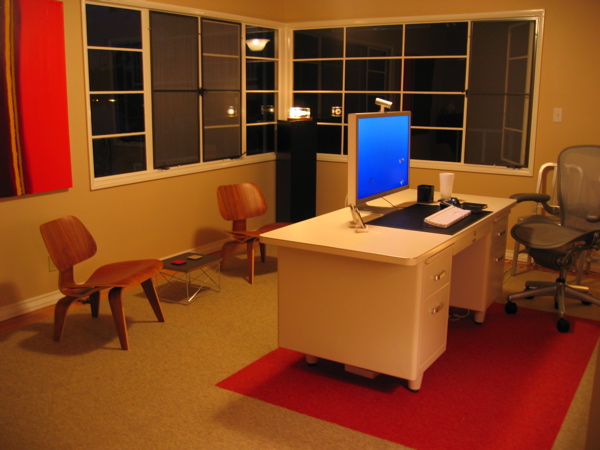
After LA, we moved to Austin. Here’s my studio/office there. I dug the vintage 1970s lucite chandelier and red velvet curtains. (As Jonathan Newman once said, “it looks like a friggin’ bordello.”
When we listed the house, it was photographed by a professional interior design photographer, Paul Finkel. (Here’s the blog post with all of his pictures of our Austin house.) You can see the difference in what he was able to do, compared to what I photographed. You’ll notice that we moved my desk when we listed the house, in an effort to make the room look bigger. We also removed my dope-so-dope chandelier.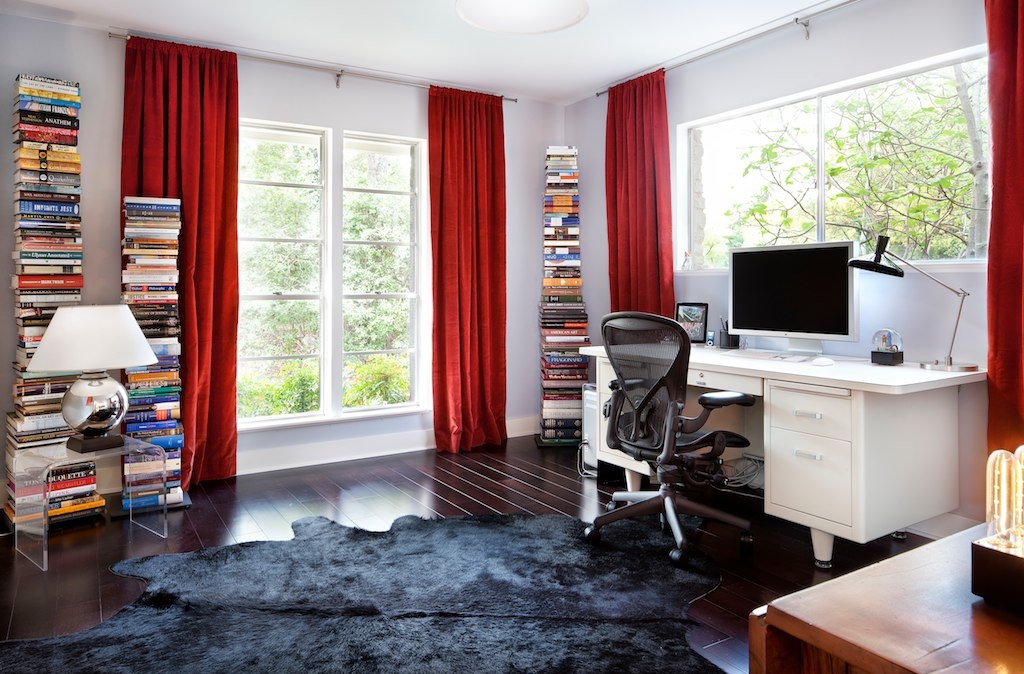
Then we moved to Cambridge, Mass — the 8th most liberal city in the US in 2005. Before we arrived in the summer of 2011, it was probably #4. Now that we’re here, it must be in the top 2. It would be a firm #1 if not for Loki. (Huge Herman Cain supporter, it turns out.)
I mentioned above that my old office desk is now in my “office.” That’s because for the first time in all of my years of writing music, I have a room that’s dedicated to doing administrative work like shipping sets of parts, and a completely different room – on a completely different floor of the house! – dedicated to writing music. Now, when I’m writing, I’m literally a floor away from all of my rental sets, so if somebody requests a set, I no longer drop whatever I’m writing and fill the order. (I used to do this because it was easier to fill an order than to write music. Now, it’s easier to write music than go all the way down a flight of stairs and down a hall. Okay, it’s not “easier” to write music, but at least I don’t have to get out of my chair and go downstairs, which is so hard.) If I get an order, I send the order to the printer downstairs, and every couple of days, I set aside a few hours to “go to the office” and fill those orders all at once. There’s no reason to show pictures of my office, because it looks like an office. A nice office, but an office. Okay, here’s a shot of the closet. Glamorous, isn’t it?
So that leaves the studio. Or “the piano room.” We haven’t decided what to call it. When we arrived in Cambridge, the “studio” (yeah, let’s go with “studio”) was more “the junk room where we’ll leave all of the used packing materials as we unpack” – or the JRWWLAOTUPMAWU room, for short.
Before too long, we had it cleaned up. The mirror was hung (and that’s not the only thing in this room that’s hung – ZING-O!), but the room is pretty empty. Nice wall color, though. We’re renting here, like we did in LA, but unlike in LA, we were able to specify all of the wall colors before we moved in. (I say “we,” but that was entirely AEJ, who spent an afternoon drawing up a floor plan and attaching paint swatches for the contractor.)
Then — carpet! These are Flor carpet tiles – probably the only affordable way to get a (fairly custom) rug for a 300-square-foot room in a rented house. In the distance, you can see the credenza, a vintage leather lounge chair, and the now-famous booby lamp. (Don’t worry; more boobies are coming up.)
The room was still pretty empty – but you could tell that I was excited for the delivery of the piano. I also hadn’t figured out where the subwoofer was going to live.
Then the piano came. (I blogged about the Disklavier here.) Everybody was much happier.
Until the piano played itself. That was kind of stressful for somebody.
So now the room had a shiny new Yamaha grand piano and some shiny speakers on one end, and a leather lounge chair, credenza, and booby lamp on the other end. (Does this picture look dirty? I hope so. I love the sexy/skeevy lounge chair, which feels like it fell out of a bachelor’s house in 1977. Also: super comfy!)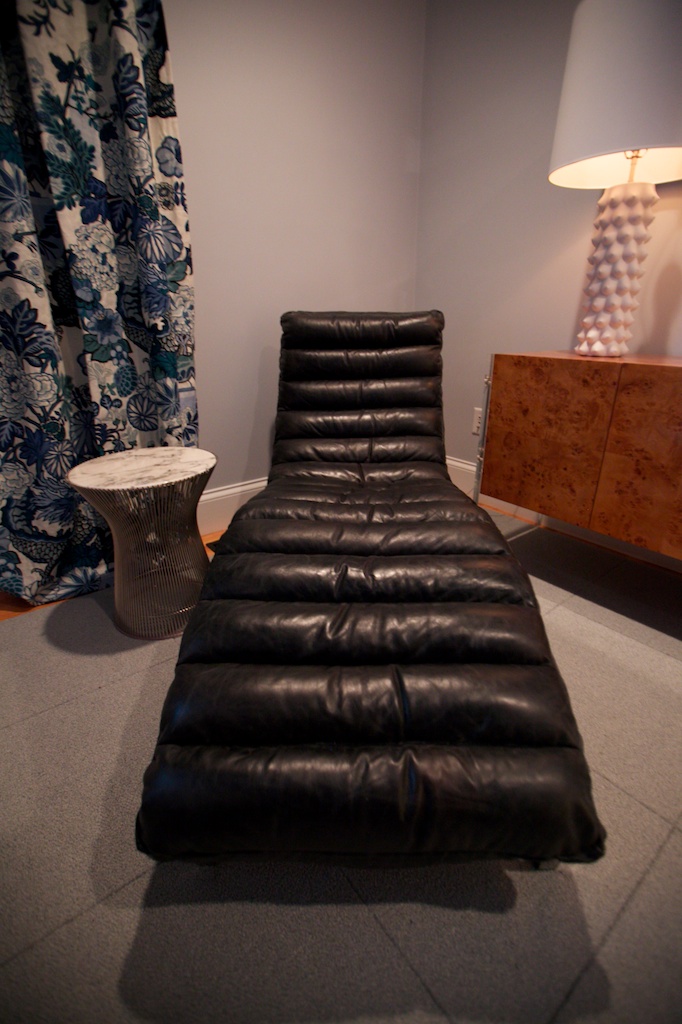
Here’s a less-suggestive angle.
The room was looking pretty sweet. I mean, we had the booby lamp.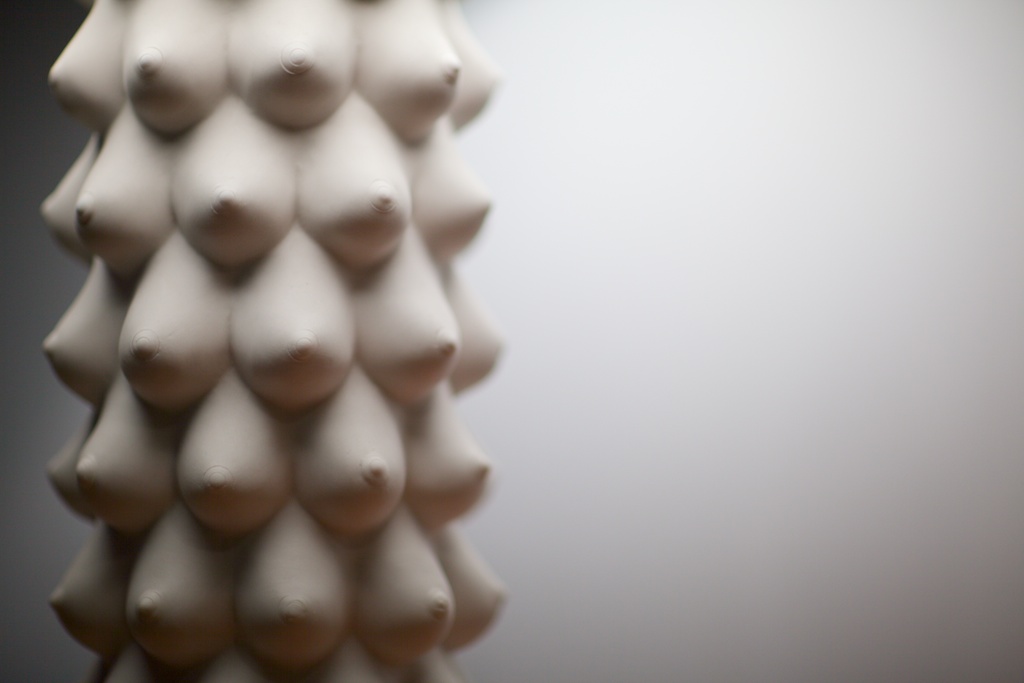
The piano.
The subwoofer, tucked (or squeezed) under the piano.
A new chair (in metallic leather).
But something was missing.
Curtains.
Custom-made curtains, from Schumacher Chiang Mai Dragon fabric. Six floor-to-ceiling panels.
Everything looks cooler with cool curtains.
Loki likes them.
Now the workspace kicks ass. (The windows have some energy-efficient coating on them, so the leaves outside look fake in this picture. I shot this at dusk, with the interior lights barely on, but with a tripod and a very long exposure. This isn’t HDR.)
The desk is a fully custom mirror-and-lucite neo-classical console. (It just arrived this afternoon!)
The mirror is trippy.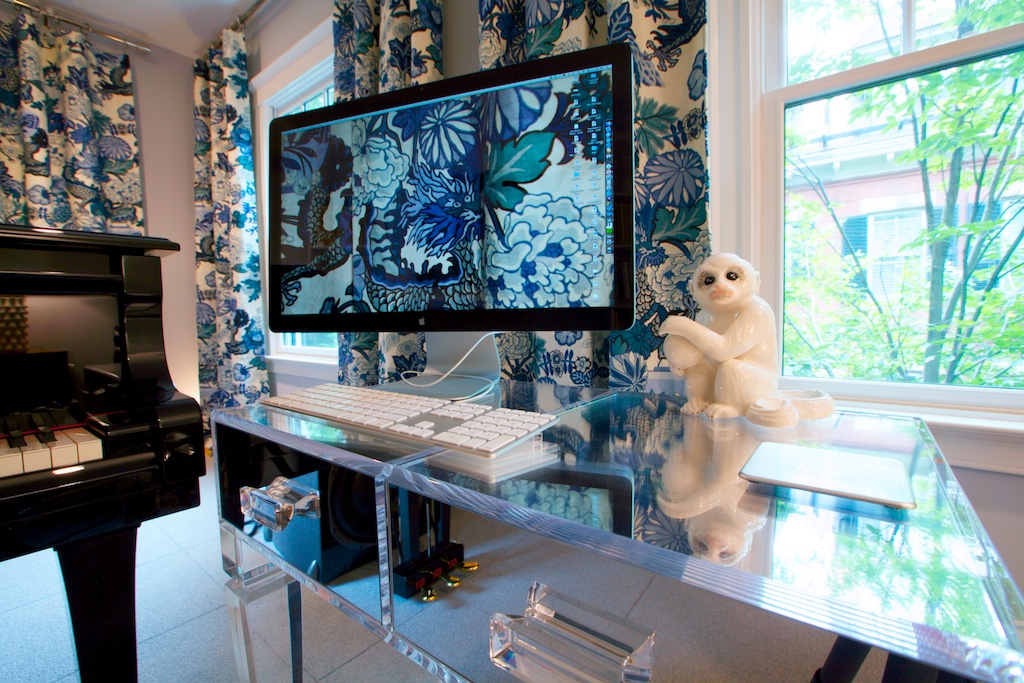
The design owes at least a little to Elvis. Here’s a replica of the monkey statue that Elvis had in the TV room of Graceland (blogged here). Hey, monkey! Share your ball, monkey! (“No,” said monkey.)
The room, as seen from the lounge chair.
The room is just loaded with shiny.
I mean, even the chair’s leather is shiny.
The room is mega-bling. AEJ has totally outdone herself with this design. I’m definitely not the best composer around, but thanks to AEJ, I’m pretty sure that I have the sweetest studio. Sadly, there is no Pulitzer for “swankiest studio.”
And what’s just outside the studio? That’s going to have to wait for another blog post…
View Comments
Comments
You need to press the damper pedal down while watching movies and see what kind of cool sympathetic vibrations come out of the piano.
Daaaaaaaaaaaamn!
Can't decide if I would get MORE or LESS done in that studio. Music, that is.
It seems like you write music and see your psychiatrist in the same room. Come for the guidance, stay for the booby lamp.
The picture with the room full of packing supplies just screams "fire hazard"!
View Comments
Comments
Scot M. Fretwell says
Nitzan and Emily are a great team!
Clark Nichols says
Why the hell was that lady there? Did you pay for her?!
Scott Pender says
Finally got around to reading this post and watching the redo of the first mvt at the Temple concert. Props to Nitzan for wanting to replay that movement, and to Emily for going with it. There are so many times when this should/could happen, but it doesn't. I'm glad to see this!
Marc Feingold says
Well, I'm so glad to have been there to capture our son performing with the Temple Wind Symphony (bassoon!). This was a first for my wife and me (seeing a re-do - and with the wonderful composer present. This is why we love that Zach is at Temple.)
Add comment